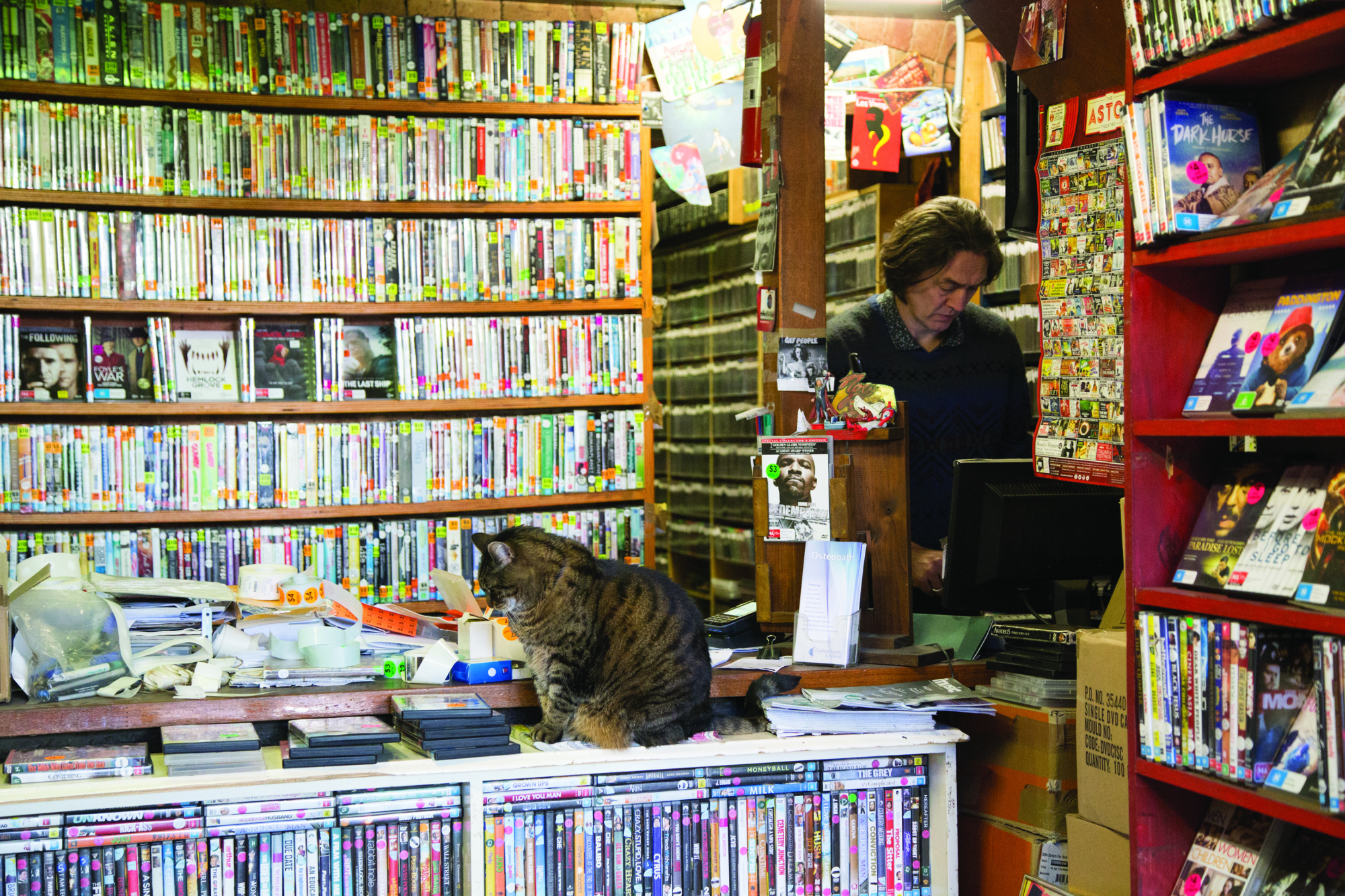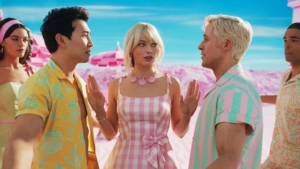I’m concerned about pictures being suggested by algorithms […] The algorithm is dangerous because it takes away from your creative viewing. I think you have to make up your own mind about creative viewing.
— Martin Scorsese[1]Martin Scorsese, quoted in Anthony Breznican, ‘Martin Scorsese Says Streaming Algorithms – Including Netflix’s – Are Ruining Audiences’, Vanity Fair, 3 January 2020, <https://www.vanityfair.com/hollywood/2020/01/martin-scorsese-streaming-algorithms-moviegoers>, accessed 27 May 2021.
The VHS died, and I guess the DVD is dying as well.
— Derek de Vreugt, owner of Picture Search Video[2]Derek de Vreugt, in ‘Episode I: Derek’, The Golden Age of Piracy, 2016.
Of all the artforms, it is perhaps film that plays the most significant role in the shaping of our identities. For many of us, there is an enduring connection between the films we experience and our subjective, ever-evolving concept of what it is to be human. The way that the medium speaks to our lived experience is unparalleled and unique: the taking up of temporal and physical dimensions; the camera movement that mirrors the actions of our own bodies; the actors replicating differing approximations of reality, sometimes reflecting and sometimes commenting on our material, emotional, psychological and intellectual spheres of existence. Movies are the stuff of both our dreams and our lived consciousness. They reach out through the recesses of time to reassure us, to entertain us, to provoke or to enlighten.
Much has been written about the dialectic relationship between film and memory: the uncanny capacity of film to represent the unreliability of our fallible brains. Two widely loved examples are Memento (Christopher Nolan, 2000) and Eternal Sunshine of the Spotless Mind (Michel Gondry, 2004). In different ways, these films interrogate the slippery terrain connecting what we ‘remember’ with what we ‘know’; they map out, in bewildering contours, the faltering, highly susceptible ‘realities’ of their protagonists. In doing so, they remind us of the need to preserve those memories that are still within reach. Cinema is the medium best equipped to bridge the distance between ‘then’ and ‘now’, ‘here’ and ‘there’. Films are material records; they are time capsules of former film movements, aesthetic tendencies, and social and political landscapes. They are a kind of stored moving memory that erodes over time, just like our own human ability to remember.
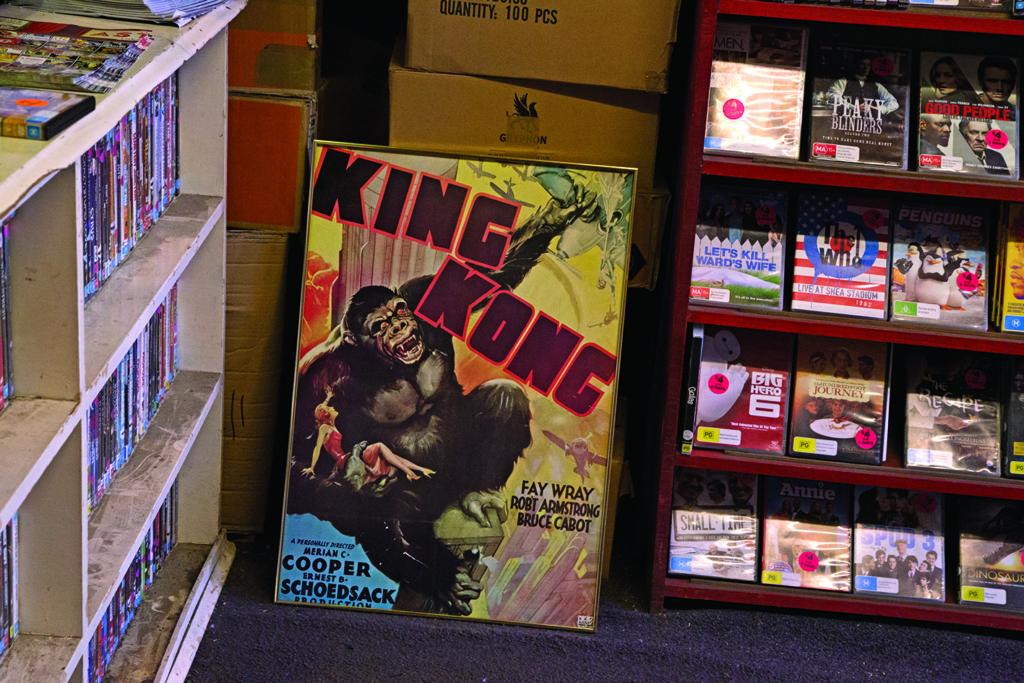
Just as movies are analogous with memory, our formative memories of loved films are often embedded within a wider framework of friends and family members. There is a collective dimension to film spectatorship that is contingent on shared experience, of gathering to watch in lounge rooms, of repeated viewings, of early visits to the cinema with our mates. These memories are powerful and enduring; they shape our sense of who we are and how we relate to the world. And there is nothing passive or arbitrary about these kinds of viewing experiences – they become part of our shared memories with other people precisely because of the ways in which our interactions are filtered through those shared experiences. This connection between identity, memory and movies means that films often operate as powerful objects of nostalgia. My mother remembers meeting her best friend for a late-night screening of Psycho (Alfred Hitchcock, 1960). They parted ways after the film, and Mum recalls running through the streets of Geelong West, exhilarated and terrified, every shadow threatening to take the form of Norman Bates (Anthony Perkins) and that knife. She relates the story with little flourishes, little adornments: ‘Was it foggy that night? I think it might have been foggy.’ The memory fades, but the essence of the experience is undiminished, impervious to the passing years.
Films are time capsules of former film movements, aesthetic tendencies, and social and political landscapes. They are a kind of stored moving memory that erodes over time, just like our own human ability to remember.
One consistent element of these formative viewing experiences is a kind of intentionality to the viewing process. My mum and her friend planned their attendance; they met on the bus en route to the cinema; they stood in a long line to buy their tickets. The accessibility and ubiquity of streaming services has diluted these kinds of experiences by directing our viewing via algorithms. Platforms like Netflix and Amazon Prime Video make it far too easy to be spoonfed content. While this can be helpful, and is definitely a win for the time-poor, it also risks taking away the viewer’s agency. There is plenty of excellent content across these providers, but there is also a risk of succumbing to the cinematic equivalent of a high-sugar diet: an instant ‘hit’ that is not particularly good for us. A 2020 Roy Morgan poll found that over 80 per cent of Australians – 17.3 million in total – watched some kind of subscription television at one point in the course of an average four weeks. And more than two-thirds watched Netflix.[3]‘Subscription TV Viewers Soared to 17.3 Million Australians During 2020: Netflix, Foxtel, Stan, Disney+ & Amazon Prime All Increased Viewership by at Least 1.5 million’, media release, Roy Morgan Research, 12 January 2021, <http://www.roymorgan.com/findings/8606-subscription-pay-tv-services-september-2020-202101120113>, accessed 10 May 2021.
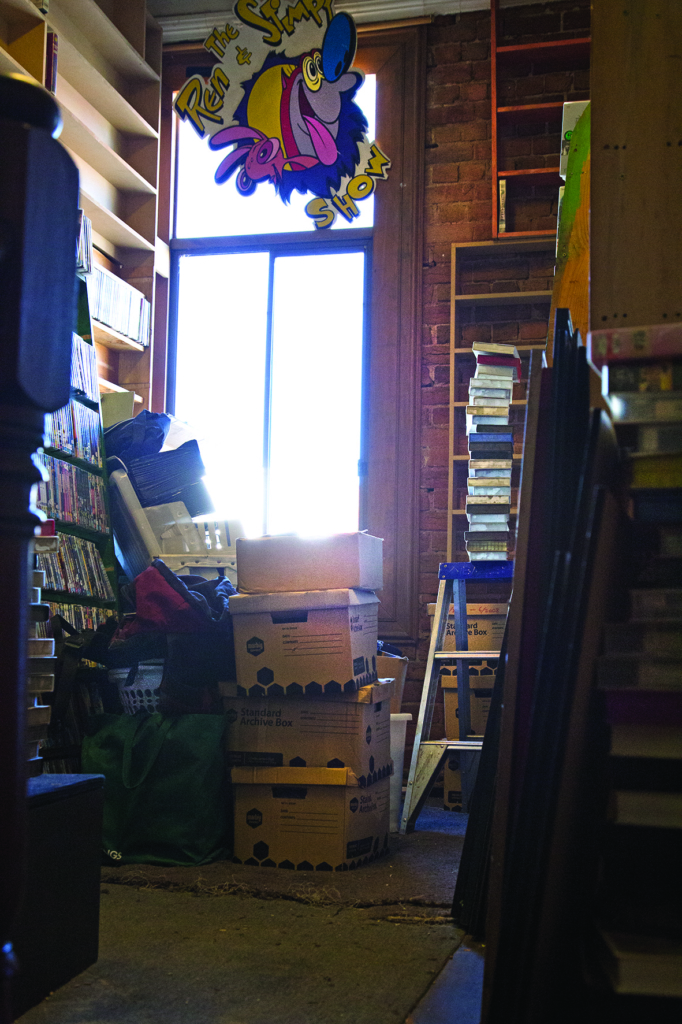
This has all but signalled the death knell for video and DVD rental businesses. In 2001, it was estimated that Australia had about 2600 video stores. In 2016, the year that the Australian Video Rental Retailers Association (AVRRA) was disbanded, that number had dropped to around 750,[4]Larissa Romensky, ‘Emotional Time as National Video Rental Association Folds, Signalling End of Industry’, ABC Central Victoria, 25 October 2016, <https://www.abc.net.au/news/2016-10-25/emotional-time-as-national-video-rental-association-folds/7963544>, accessed 2 May 2021. and more recent estimates put the figure at somewhere under 500.[5]Phil Brandel, ‘The Last Video Stores in Far North Queensland Are About to Close for Good’, ABC Far North, 1 May 2021, <https://www.abc.net.au/news/2021-05-01/streaming-kills-the-video-store/100107536>, accessed 27 May 2021. Former AVRRA board director Scott Dew has emphasised the social cost of these closures to the community: ‘[It’s] a big loss because [for] a lot of people, it was a very social thing, coming out on a Friday night to get your take-away food, catch up with friends and get a movie.’[6]Scott Dew, quoted in Romensky, op. cit.
Picture Search Video, located in the inner-city Melbourne suburb of Richmond, is the last remaining DVD rental store in its area, and one of just a handful of shops of its kind still operating in the city. As well as storing an extensive archive of both lesser-known and canonical titles, many of which are not readily available elsewhere, the store itself is a kind of time capsule. It offers a nostalgia hit with its three levels, its rickety stairs, its glorious dusty retro appeal (it even still carries a sizeable VHS collection). And the prices are similarly frozen in time; renting five weekly films will set you back A$10. In the 2016 ABC iview series The Golden Age of Piracy, the store’s owner, Derek de Vreugt, emphasises the comparative lack of choice on internet services:
I think your choice might be directed on the internet because you go, ‘Oh, it’s not available; I’ll watch something else instead.’ So you don’t actually get to watch what you wanted to watch, perhaps […] There will be movies that people will not be able to see – that maybe are important – if we close our doors.[7]Derek de Vreugt, in ‘Episode III: MPAA vs. VHS’, The Golden Age of Piracy, 2016.
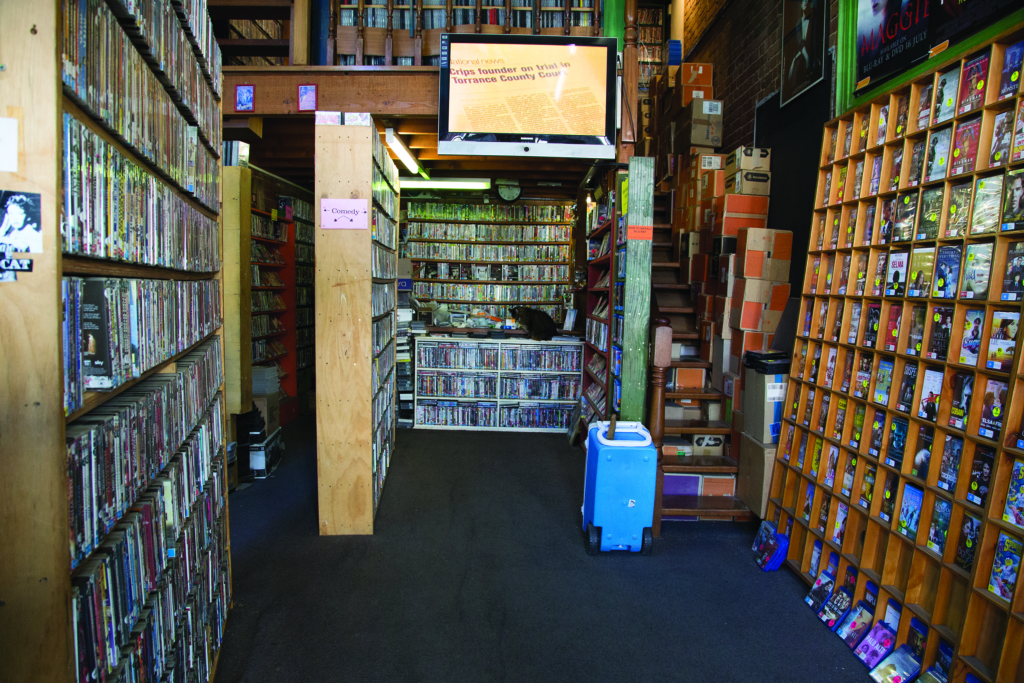
Picture Search is emblematic of an essential part of our film ecology that risks being displaced by dispassionate algorithms. The instant hit of a streaming service provides an essentially affectless ‘encounter’ between an (often solitary) spectator and their nearest screen, whether it be a television, laptop, iPad or mobile phone. De Vreugt’s store offers a human counterpoint to this mode of interaction; it is a precious antidote precisely because it retains the experiential aspect of film culture. Within this dedicated space, the physical transaction is permitted to displace the digital, if only momentarily.
The instant hit of a streaming service provides an essentially affectless ‘encounter’ between an (often solitary) spectator and their nearest screen, whether it be a television, laptop, iPad or mobile phone.
It is not overstating its significance to suggest that the store is a kind of living cultural artefact: it is a place that stands outside of time, one that actively resists transforming itself in order to appeal to customers. There are no bags of popcorn or ice creams for sale here, and no $2 Tuesday specials. The shop does not offer a website where you can look up titles, and there is no service that posts out DVDs in the mail. Instead, it is a space to linger; to deliberate; to discuss movies, directors, performances, favourite genres. And, significantly, it is a place to plan viewings, browse the aisles and take the time to select titles. A visit to Picture Search is intentional and personal; it offers a way for the distinctive alchemy of cinema to ignite our neural pathways from the minute the bell chimes to announce our arrival into the store. In this way, our memories of the films we watch might be textured by a gruff recommendation from de Vreugt, or the rainy evening we had to contend with in order to get to the Swan Street establishment.
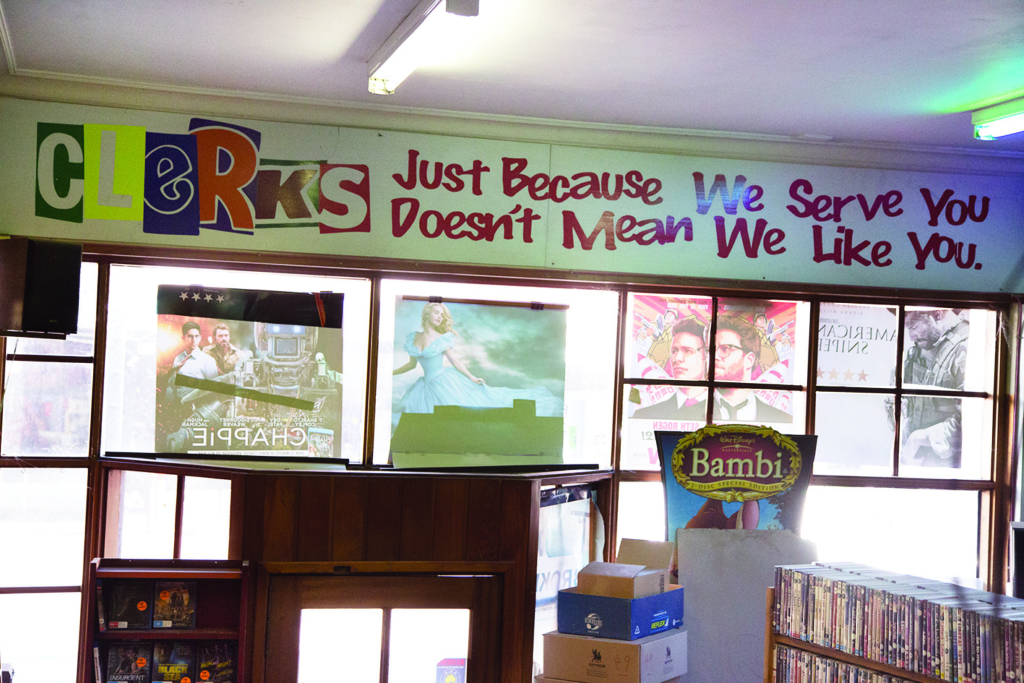
A store like Picture Search becomes even more vital when considering the effect that the ascendancy of streaming is having on cinemas. In December 2020, Warner Bros. announced a twelve-month deal with the streaming service HBO, meaning that blockbuster films like Wonder Woman 1984 (Patti Jenkins, 2020) and the forthcoming Dune (Denis Villeneuve, 2021) would be released simultaneously theatrically and on demand.[8]Guy Lodge, ‘Stream On’, Sight & Sound, vol. 31, no. 2, March 2021, p. 13. Director Villeneuve summed up this situation succinctly: ‘There is absolutely no love for cinema, nor for the audience here. It is all about the survival of a telecom mammoth.’[9]Denis Villeneuve, ‘Dune Director Denis Villeneuve Blasts HBO Max Deal (EXCLUSIVE)’, Variety, 10 December 2020, <https://variety.com/2020/film/news/dune-denis-villeneuve-blasts-warner-bros-1234851270/>, accessed 2 June 2021. This is symptomatic of a growing trend for films to be released directly to streaming services. Netflix has plenty of form in this space, controversially obtaining release rights to highly anticipated films like Roma (Alfonso Cuarón, 2018) and Annihilation (Alex Garland, 2018). More recently, they have stepped this level of ownership up even further by producing as well as distributing high-profile ‘prestige’ films such as Mank (David Fincher, 2020), which only tend to receive limited theatrical releases at best.
While the increasing monopolisation of streaming services is forcing a movement away from the big-screen experience, it is also affecting back catalogues. Artificial scarcity is engendered through the alarming practice of ‘vaulting’, the phenomenon in which studios such as Walt Disney Pictures arbitrarily remove films from circulation or refuse to give cinemas screening rights to particular titles.[10]See Matt Zoller Seitz, ‘Disney Is Quietly Placing Classic Fox Movies Into Its Vault, and That’s Worrying’, Vulture, 24 October 2019, <https://www.vulture.com/2019/10/disney-is-quietly-placing-classic-fox-movies-into-its-vault.html>, accessed 2 June 2021. Picture Search is not only free of such cynical limitations, but a visit to the store is also an opportunity to reclaim the more communal aspects of cinema spectatorship – particularly valuable in this time of periodically enforced and slowly thawing isolation.
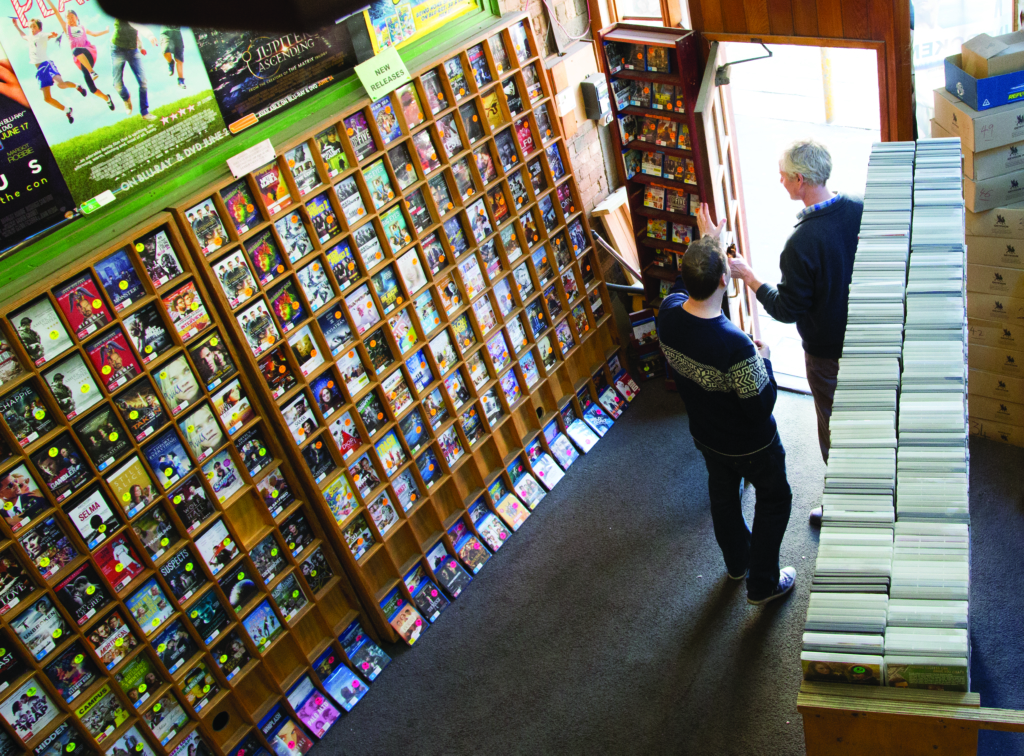
And let’s not forget the demographic that will be the most significantly impacted by the death of the video store: elderly, less internet-savvy viewers, many of whom have remained relatively inured to technological advancements and are far more likely to rely on a bricks-and-mortar establishment for access to movies. The DVD Collection, which sells rather than rents DVDs, has managed to stay afloat thanks to the service it provides its older patrons, many of whom are returning customers who have frequented the store – which was until recently based in the city’s CBD, and is now located in the outer Melbourne suburb of Tullamarine – for many years. As owner Jeanette Bresaz explained in a 2019 interview, the shop has survived through their willingness to order in films that are not available elsewhere when customers request them:
That’s how we’ve managed to keep going. A lot of our customers are over 60 and don’t want to go online. It’s easier for them to come in and get it from us, and more often than not it’s for the same price.[11]Jeanette Bresaz, quoted in Denham Sadler, ‘How the Last Video Stores Are Surviving in the Age of Netflix’, Commercial Real Estate, 16 April 2019, <https://www.commercialrealestate.com.au/news/how-the-last-video-stores-are-surviving-in-the-age-of-netflix-43337/>, accessed 28 April 2021.
Long gone are the days when a trip to the local video store was an essential component in people’s domestic rituals – a place where families, couples or groups of friends would converge to select a new release or pick up a handful of weekly rentals. In The Golden Age of Piracy, de Vreugt speaks fondly of earlier years at Picture Search, recalling,
[The period from] 2007 to 2011 was probably the time to make money out of the DVD hiring business. [It was] like being in a busy bar sometimes: there was a crowd of people in front of the overnight release [section], and I was embarrassed that I didn’t have much room in my shop.[12]De Vreugt, in ‘Episode III: MPAA vs. VHS’, op. cit.
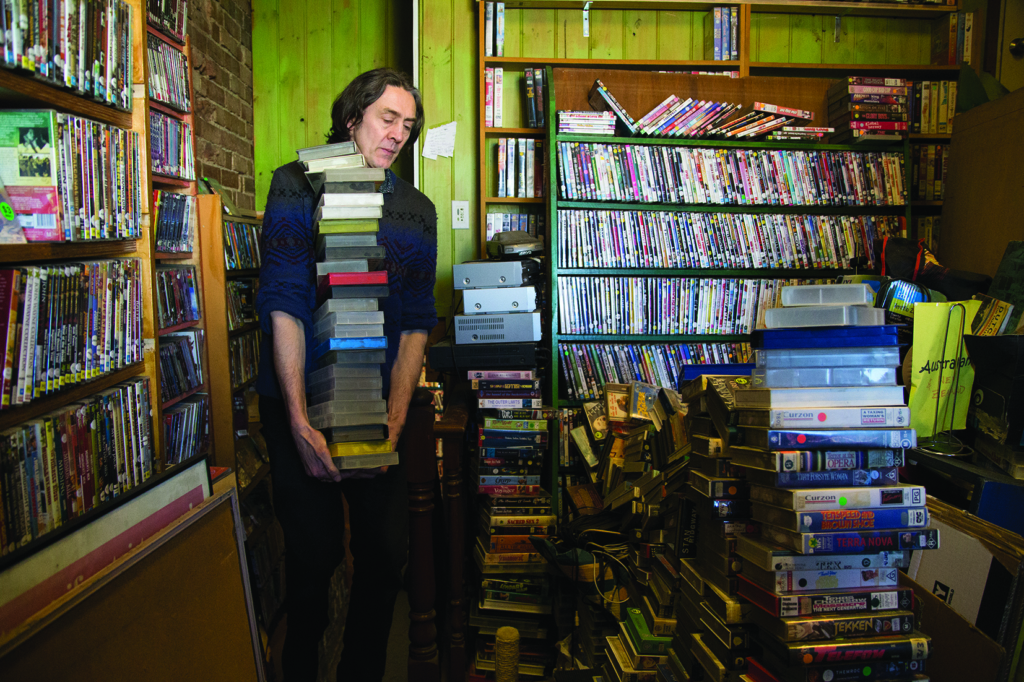
This social aspect of the video store experience was crucial, he notes: ‘It’s really nice to have a conversation [with] people when they’re moved by something, and I think that’s what it is – it’s about sharing something you really enjoy.’[13]De Vreugt, in ‘Episode I: Derek’, op. cit.
It’s this human interaction that is arguably every bit as important as the range of films that stores like Picture Search are able to offer. What is lost in the disappearance of video stores is the conversations, cinephile to cinephile; the shared memories of great films; the suggestions of what to watch next. De Vreugt’s emphasis on these kinds of shared encounters reminds us of the essential role that connections between lovers of the artform play in film culture. In this way, the video store becomes a metaphor for that ecosystem’s very best aspects – and the few that still exist remind us of the ways that cinema, memory and personal identity can beautifully coalesce within their crumbling architecture.
Endnotes
| 1 | Martin Scorsese, quoted in Anthony Breznican, ‘Martin Scorsese Says Streaming Algorithms – Including Netflix’s – Are Ruining Audiences’, Vanity Fair, 3 January 2020, <https://www.vanityfair.com/hollywood/2020/01/martin-scorsese-streaming-algorithms-moviegoers>, accessed 27 May 2021. |
|---|---|
| 2 | Derek de Vreugt, in ‘Episode I: Derek’, The Golden Age of Piracy, 2016. |
| 3 | ‘Subscription TV Viewers Soared to 17.3 Million Australians During 2020: Netflix, Foxtel, Stan, Disney+ & Amazon Prime All Increased Viewership by at Least 1.5 million’, media release, Roy Morgan Research, 12 January 2021, <http://www.roymorgan.com/findings/8606-subscription-pay-tv-services-september-2020-202101120113>, accessed 10 May 2021. |
| 4 | Larissa Romensky, ‘Emotional Time as National Video Rental Association Folds, Signalling End of Industry’, ABC Central Victoria, 25 October 2016, <https://www.abc.net.au/news/2016-10-25/emotional-time-as-national-video-rental-association-folds/7963544>, accessed 2 May 2021. |
| 5 | Phil Brandel, ‘The Last Video Stores in Far North Queensland Are About to Close for Good’, ABC Far North, 1 May 2021, <https://www.abc.net.au/news/2021-05-01/streaming-kills-the-video-store/100107536>, accessed 27 May 2021. |
| 6 | Scott Dew, quoted in Romensky, op. cit. |
| 7 | Derek de Vreugt, in ‘Episode III: MPAA vs. VHS’, The Golden Age of Piracy, 2016. |
| 8 | Guy Lodge, ‘Stream On’, Sight & Sound, vol. 31, no. 2, March 2021, p. 13. |
| 9 | Denis Villeneuve, ‘Dune Director Denis Villeneuve Blasts HBO Max Deal (EXCLUSIVE)’, Variety, 10 December 2020, <https://variety.com/2020/film/news/dune-denis-villeneuve-blasts-warner-bros-1234851270/>, accessed 2 June 2021. |
| 10 | See Matt Zoller Seitz, ‘Disney Is Quietly Placing Classic Fox Movies Into Its Vault, and That’s Worrying’, Vulture, 24 October 2019, <https://www.vulture.com/2019/10/disney-is-quietly-placing-classic-fox-movies-into-its-vault.html>, accessed 2 June 2021. |
| 11 | Jeanette Bresaz, quoted in Denham Sadler, ‘How the Last Video Stores Are Surviving in the Age of Netflix’, Commercial Real Estate, 16 April 2019, <https://www.commercialrealestate.com.au/news/how-the-last-video-stores-are-surviving-in-the-age-of-netflix-43337/>, accessed 28 April 2021. |
| 12 | De Vreugt, in ‘Episode III: MPAA vs. VHS’, op. cit. |
| 13 | De Vreugt, in ‘Episode I: Derek’, op. cit. |
